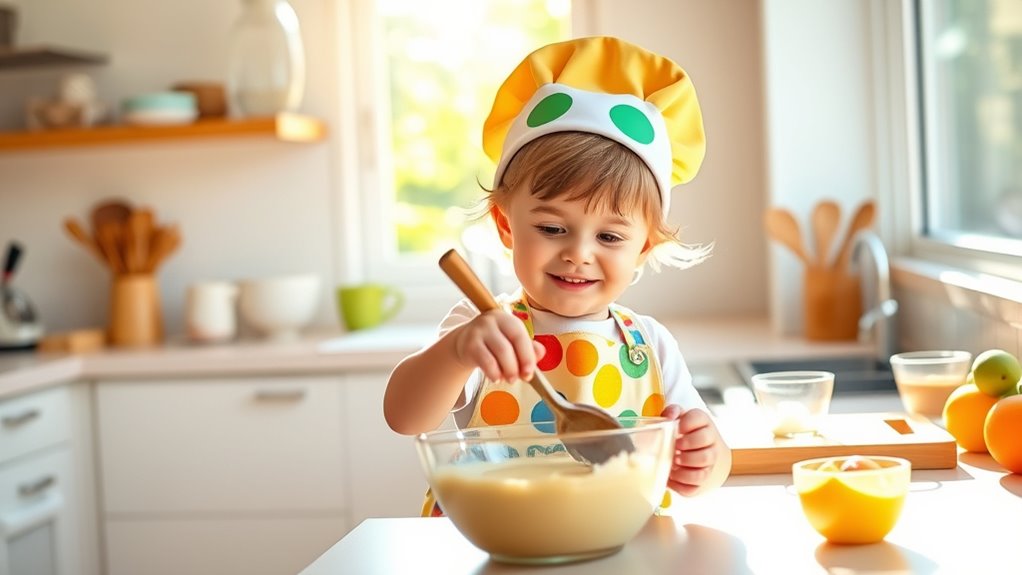When cooking with kids, focus on safety by establishing clear rules, supervising closely, and keeping sharp or hot items out of reach. Choose recipes suited to their age, starting with simple tasks like mixing or assembling snacks, then gradually introducing more complex activities as their skills grow. Encourage questions, celebrate small successes, and keep the workspace organized. To inspire confidence and a love of cooking, you’ll find more ideas on how to match tasks and safety tips as you continue exploring.
Key Takeaways
- Prioritize kitchen safety by establishing clear rules, supervising closely, and keeping hot surfaces and sharp utensils out of children’s reach.
- Match recipes and tasks to children’s developmental stages, starting with simple, no-cook activities and gradually increasing complexity.
- Teach proper utensil handling, handwashing, and safe food practices to instill lifelong safe cooking habits.
- Organize workspace and tools for independence, encouraging children to participate actively while supervised at all times.
- Use outdoor or nature-based activities to enhance understanding of food origins and create engaging, safe learning experiences.

Have you ever wondered how to turn mealtime into a fun, educational experience? Cooking with kids offers a wonderful opportunity to teach them essential life skills while creating delicious memories together. The key is to prioritize kitchen safety and select age-appropriate recipes that match your child’s developmental stage. When you involve children in the kitchen, it’s vital to establish clear safety rules upfront. Show them how to handle utensils carefully, emphasize the importance of washing hands before starting, and keep hot surfaces and sharp objects out of reach. Keeping the environment safe encourages confidence and minimizes accidents. Tailoring recipes to your child’s age makes the process more manageable and enjoyable for everyone. For younger kids, choose simple, no-cook tasks like mixing ingredients or assembling snacks. These activities allow them to participate actively without the risk of burns or cuts. As they grow and develop better coordination, introduce more complex tasks such as stirring, pouring, or using kid-friendly knives under close supervision. For older children, you can gradually increase the difficulty level by involving them in chopping vegetables, measuring ingredients, or even assisting with oven work. The idea is to match the recipe complexity with their abilities, so they feel successful and motivated to learn. When selecting recipes, focus on those that are straightforward and forgiving, especially when kids are new to cooking. This reduces frustration and keeps the experience fun. Using age-appropriate recipes also helps build their confidence as they see tangible results from their efforts. Additionally, incorporating outdoor or nature-based activities can enhance their overall learning experience and foster a deeper appreciation for food origins. Remember, safety doesn’t end with the recipe choice; always supervise closely, especially when your child is working near heat sources or sharp tools. Explain each step clearly, and encourage questions to foster a sense of curiosity and learning. Make sure the workspace is organized, with all necessary tools within easy reach, so your child can work independently without feeling overwhelmed. Celebrate their achievements, no matter how small, to reinforce their enthusiasm for cooking. By combining kitchen safety with age-appropriate recipes, you’re creating a nurturing environment where your child can develop essential skills while enjoying the process. This approach not only keeps everyone safe but also turns cooking into a fun, memorable activity that promotes independence and a lifelong love of learning in the kitchen.
Frequently Asked Questions
What Are the Best Age-Appropriate Kitchen Tools for Kids?
You should choose child-friendly utensils and age-appropriate gadgets for your kids. For young children, look for tools with rounded edges, easy-to-hold handles, and non-slip features. As they grow, introduce safer knives, graters, and measuring cups designed specifically for their size and skill level. These tools help build confidence, guarantee safety, and make cooking fun, encouraging your kids to develop essential skills while minimizing risks.
How Can I Prevent Kitchen Accidents During Cooking With Children?
Think of your kitchen as a delicate balance beam—you need to keep it steady. To prevent accidents, always supervise your child closely, like a lighthouse guiding ships safely. Create safe cooking zones away from sharp knives and hot surfaces, and teach them proper handling. Keep gadgets out of reach, and use age-appropriate tools. With vigilant supervision and designated safe areas, you keep the kitchen a fun, accident-free space for everyone.
What Are Healthy Snack Ideas for Kids in the Kitchen?
You can whip up healthy snacks like fruit and veggie sticks, yogurt parfaits, and whole-grain crackers with cheese. Kid-friendly recipes such as smoothies, homemade trail mix, or mini sandwiches also work well. Involve your kids in preparing these snacks to make healthy eating fun and engaging. Not only do they enjoy the process, but they also learn good habits that last a lifetime.
How Do I Teach Kids About Food Safety and Hygiene?
To teach kids about food safety and hygiene, start by explaining food allergy awareness and emphasizing the importance of avoiding cross-contact. Show them proper handwashing techniques, like scrubbing with soap for at least 20 seconds before handling food. Use simple, clear instructions and make it fun. Reinforce these habits regularly, so they develop good hygiene practices, understand allergies, and stay safe while cooking and eating.
What Should I Do if a Child Gets Injured While Cooking?
An injury in the kitchen can feel like a rollercoaster, but stay calm. First, quickly assess the injury, applying first aid basics like stopping bleeding or cleaning a cut. If needed, call emergency contacts immediately. Keep a well-stocked first aid kit nearby and reassure the child. Stay with them, monitor their condition, and seek medical help if the injury worsens or if you’re unsure about the severity.
Conclusion
Cooking with kids is like planting seeds for a lifetime of healthy habits and confidence. By prioritizing safety, teaching skills step by step, and choosing age-appropriate tasks, you create a nurturing environment where they can grow. Remember, patience is your guiding compass—sometimes there will be spills, but each mess is just a stepping stone. With your guidance, those little hands will blossom into confident cooks, ready to take on the culinary world one dish at a time.









